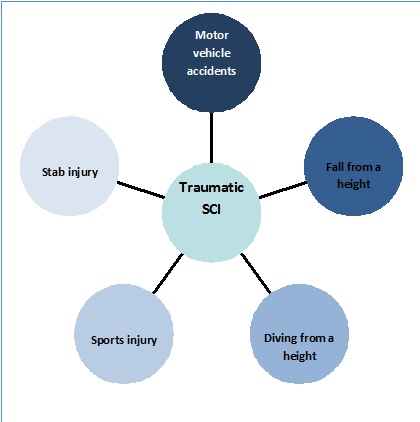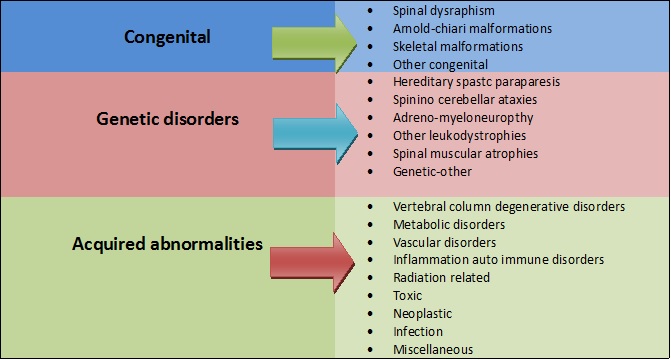Overview of Spinal Cord Injuries: Difference between revisions
No edit summary |
No edit summary |
||
| Line 10: | Line 10: | ||
== What is a Spinal Cord Injury == | == What is a Spinal Cord Injury == | ||
Spinal Cord | Spinal Cord Injury (SCI) is a sudden onset disruption to the neuronal tisue within the spinal canal resulting in spinal cord damage as a result trauma, disease or degeneration. <ref name=":0">Stack E, Stokes M, editors. Physical Management for Neurological Conditions. Elsevier Churchill Livingstone; 2012.</ref><ref name=":1">Harvey L. Management of Spinal Cord Injuries: A Guide for Physiotherapists. Elsevier Health Sciences; 2008 Jan 10.</ref> It presents as either an upper motor neurone lesion or lower motor neurone lesion with varying loss of motor, sensory and autonomic function, either temporary or permanent depending on the level and type of injury to the Spinal Cord.<ref name=":1" /><ref>Tymianski, D., Sarro, A. Green, T. (2012). Navigating Neuroscience Nursing: A Canadian Perspective. 1st Ed. Pappin Communications, Pembroke, Ontario</ref> Classification of Spinal Cord Injury is conducted according to the degree of sparing of movement and sensation below the level of the Injury using the ASIA Impairment Scale. <ref>Kirshblum SC, Burns SP, Biering-Sorensen F, Donovan W, Graves DE, Jha A et al. International standards for neurological classification of spinal cord injury (revised 2011). J Spinal Cord Med 2011; 34: 535-546</ref> | ||
''Paraplegia'' refers to impairment or loss of motor, sensory or autonomic function in areas of the body served by the thoracic, lumbar or sacral segments of the spinal cord. Depending on the level of the injury trunk, pelvic organs and lower limbs may be involved with upper limb function preserved.<ref name=":0" /> | |||
< | ''Tetraplegia'', sometimes referred to as quadriplegia, refers to impairment or loss of motor, sensory or autonomic function in areas of the body served by the cervical segments of the spinal cord. This results in impairment in upper and lower limbs, trunk and pelvic organs with respiratory function impaired in those with high cervical injuries.<ref name=":0" />{{#ev:vimeo|65471467|300}} | ||
== Clinically Relevant Anatomy == | == Clinically Relevant Anatomy == | ||
Revision as of 13:33, 29 October 2018
- Please do not edit unless you are involved in this project, but please come back in the near future to check out new information!!
- If you would like to get involved in this project and earn accreditation for your contributions, [[[Special:Contact|please get in touch]]]!
Original Editor - Kudzanayi Ronald Muzenda
Top Contributors - Naomi O'Reilly, Kudzanayi Ronald Muzenda, Kim Jackson, Admin, Tarina van der Stockt, Rucha Gadgil, Jess Bell, Lucinda hampton and Ewa Jaraczewska
What is a Spinal Cord Injury [edit | edit source]
Spinal Cord Injury (SCI) is a sudden onset disruption to the neuronal tisue within the spinal canal resulting in spinal cord damage as a result trauma, disease or degeneration. [1][2] It presents as either an upper motor neurone lesion or lower motor neurone lesion with varying loss of motor, sensory and autonomic function, either temporary or permanent depending on the level and type of injury to the Spinal Cord.[2][3] Classification of Spinal Cord Injury is conducted according to the degree of sparing of movement and sensation below the level of the Injury using the ASIA Impairment Scale. [4]
Paraplegia refers to impairment or loss of motor, sensory or autonomic function in areas of the body served by the thoracic, lumbar or sacral segments of the spinal cord. Depending on the level of the injury trunk, pelvic organs and lower limbs may be involved with upper limb function preserved.[1]
Tetraplegia, sometimes referred to as quadriplegia, refers to impairment or loss of motor, sensory or autonomic function in areas of the body served by the cervical segments of the spinal cord. This results in impairment in upper and lower limbs, trunk and pelvic organs with respiratory function impaired in those with high cervical injuries.[1]
Clinically Relevant Anatomy[edit | edit source]
Epidemiology / Etiology[edit | edit source]
Causes of SCI can either be traumatic or non traumatic
Traumatic causes of Spinal Cord Injuries [5][edit | edit source]
The diagram below shows the traumatic causes of of SCI
Non-traumatic causes of Spinal cord injuries[6][edit | edit source]
The table below shows a summary of non- traumatic causes of SCI injuries
Management[edit | edit source]
Conservative Management[edit | edit source]
Surgical Management[edit | edit source]
Types of Spinal Cord injuries[edit | edit source]
Paraplegia
Rehabilitation of Spinal Cord injuries[edit | edit source]
References[edit | edit source]
- ↑ 1.0 1.1 1.2 Stack E, Stokes M, editors. Physical Management for Neurological Conditions. Elsevier Churchill Livingstone; 2012.
- ↑ 2.0 2.1 Harvey L. Management of Spinal Cord Injuries: A Guide for Physiotherapists. Elsevier Health Sciences; 2008 Jan 10.
- ↑ Tymianski, D., Sarro, A. Green, T. (2012). Navigating Neuroscience Nursing: A Canadian Perspective. 1st Ed. Pappin Communications, Pembroke, Ontario
- ↑ Kirshblum SC, Burns SP, Biering-Sorensen F, Donovan W, Graves DE, Jha A et al. International standards for neurological classification of spinal cord injury (revised 2011). J Spinal Cord Med 2011; 34: 535-546
- ↑ Ackery A, Tator C, Krassioukov A. A global perspective on spinal cord injury epidemiology. J Neurotrauma 2004; 21: 1355-1370
- ↑ Biering-Sørensen F, Charlifue S, DeVivo M, Noonan V, Post M, Stripling T, Wing P. International Spinal Cord Injury Data Sets. Spinal Cord. 2006 Sep;44(9):530-4.).








